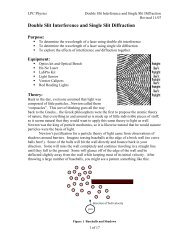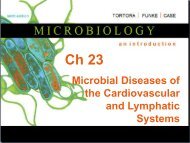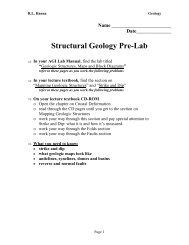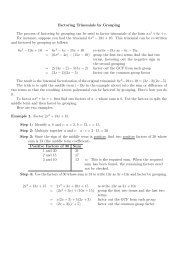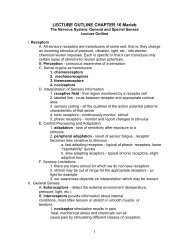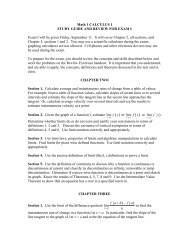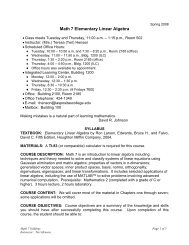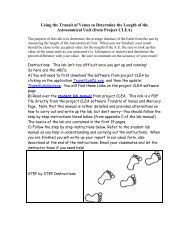Innate Immunity: Nonspecific Defenses of the Host
Innate Immunity: Nonspecific Defenses of the Host
Innate Immunity: Nonspecific Defenses of the Host
You also want an ePaper? Increase the reach of your titles
YUMPU automatically turns print PDFs into web optimized ePapers that Google loves.
16<br />
<strong>Innate</strong><br />
<strong>Immunity</strong>:<br />
<strong>Nonspecific</strong><br />
<strong>Defenses</strong><br />
<strong>of</strong> <strong>the</strong> <strong>Host</strong>
SLOs<br />
Differentiate between innate and adaptive immunity.<br />
Define toll-like receptors.<br />
Differentiate physical from chemical factors, and list examples <strong>of</strong><br />
each.<br />
Describe <strong>the</strong> role <strong>of</strong> normal microbiota in innate resistance.<br />
Classify phagocytic cells, and describe <strong>the</strong> roles <strong>of</strong> granulocytes and<br />
monocytes.<br />
Define and explain phagocyte and phagocytosis.<br />
Explain <strong>the</strong> different stages <strong>of</strong> inflammation.<br />
Describe <strong>the</strong> cause and effects <strong>of</strong> fever.<br />
Describe two <strong>of</strong> <strong>the</strong> three pathways <strong>of</strong> activating complement and<br />
describe <strong>the</strong> 3 outcomes.<br />
Compare and contrast <strong>the</strong> actions <strong>of</strong> -IFN and -IFN with -IFN.<br />
Describe <strong>the</strong> role <strong>of</strong> transferrins and antimicrobial peptides in innate<br />
Copyright © 2006 Pearson Education, Inc., publishing as Benjamin Cummings
TLRs on Ms,<br />
dendritic cells,<br />
epi<strong>the</strong>lial cells<br />
Cytokines!<br />
PAMPs recognition
Horseshoe structure <strong>of</strong> TLR3, showing attached sugars<br />
(spheres) and internal structures<br />
Fig. 16.7
The Concept <strong>of</strong> <strong>Immunity</strong><br />
• Susceptibility: Lack <strong>of</strong> resistance to a disease.<br />
• <strong>Immunity</strong>: Ability to ward <strong>of</strong>f disease.<br />
• <strong>Innate</strong> immunity: <strong>Defenses</strong> against any pathogen.<br />
• Adaptive immunity: <strong>Immunity</strong>, resistance to a specific<br />
pathogen.<br />
Copyright © 2006 Pearson Education, Inc., publishing as Benjamin Cummings<br />
Fig 16.1
First Line <strong>of</strong> Defense:<br />
Skin and Mucous Membranes<br />
Physical Factors<br />
• Epidermis: consists <strong>of</strong> tightly packed cells with<br />
keratin, a protective protein<br />
• Two o<strong>the</strong>r protective physical factors <strong>of</strong> skin?<br />
• Mucus <strong>of</strong> mucous membranes<br />
• Lacrimal apparatus<br />
• Saliva<br />
• Nose hairs<br />
• (Muco)-ciliary escalator<br />
Fig 16.3<br />
Copyright © 2006 Pearson Education, Inc., publishing as Benjamin Cummings
Chemical Factors<br />
• Fungistatic fatty acids in sebum<br />
• Low pH (3-5) <strong>of</strong> skin<br />
• Lysozyme in _______________________<br />
• Low pH (?) <strong>of</strong> gastric juice<br />
• Transferrins in blood<br />
Also important: Antagonism and<br />
competitive exclusion <strong>of</strong> normal microbiota<br />
Copyright © 2006 Pearson Education, Inc., publishing as Benjamin Cummings
1 st Line<br />
Defense in<br />
Human<br />
ANIMATION <strong>Host</strong><br />
<strong>Defenses</strong>: The Big Picture
Second Line <strong>of</strong> Defense: Formed Elements<br />
in Blood Compare to Table 16.1<br />
60-70%<br />
2-4%<br />
0.5-1%%<br />
3-8%<br />
20-25%<br />
Copyright © 2006 Pearson Education, Inc., publishing as Benjamin Cummings
Process <strong>of</strong> Phagocytosis<br />
Phagocytes engulf and kill microorganisms<br />
Steps <strong>of</strong> phagocytosis:<br />
• Chemotaxis<br />
• Recognition and attachment<br />
• Engulfment and creation <strong>of</strong> phagosome<br />
• Fusion <strong>of</strong> phagosome with lysosome<br />
• Destruction and digestion<br />
• Residual body Exocytosis<br />
Copyright © 2006 Pearson Education, Inc., publishing as Benjamin Cummings<br />
Fig 16.7
Phagocytosis<br />
Foundation Fig<br />
16.7
Microbial Evasion <strong>of</strong> Phagocytosis<br />
Inhibit adherence: M<br />
protein, capsules<br />
Kill phagocytes:<br />
Leukocidins<br />
Lyse phagocytes:<br />
Membrane attack<br />
complex<br />
Escape phagosome<br />
Prevent phagosomelysosome<br />
fusion<br />
Survive in<br />
phagolysosome<br />
Streptococcus pyogenes, S.<br />
pneumoniae<br />
Staphylococcus aureus<br />
Listeriamonocytogenes<br />
Shigella<br />
HIV<br />
Coxiella burnetti
Phagocytosis and Evasion <strong>of</strong> Phagocytosis<br />
ANIMATION Phagocytosis: Overview<br />
ANIMATION Phagocytosis: Mechanism<br />
ANIMATION Virulence Factors: Hiding From <strong>Host</strong> <strong>Defenses</strong><br />
ANIMATION Virulence Factors: Inactivating <strong>Host</strong> <strong>Defenses</strong><br />
ANIMATION Phagocytosis: Microbes That Evade It<br />
Copyright © 2006 Pearson Education, Inc., publishing as Benjamin Cummings
Inflammation<br />
Tissue damage leads to inflammatory response<br />
Purpose:<br />
• Destroy pathogen<br />
• limit spread <strong>of</strong> infection<br />
• pave way for tissue repair<br />
4 cardinal signs:?<br />
Acute-phase proteins (Chemical mediators)<br />
activated:<br />
• Complement proteins<br />
• Cytokines<br />
• Specialized proteins such as fibrinogen and<br />
bradykinin<br />
Copyright © 2006 Pearson Education, Inc., publishing as Benjamin Cummings
The Three Stages <strong>of</strong> Inflammation<br />
1. Vasodilation and increased vessel permeability<br />
due to histamine (and o<strong>the</strong>r cytokine) release <br />
edema<br />
2. Phagocyte migration and phagocytosis<br />
Margination and diapedesis (emigration)<br />
Chemotaxis(due to various cytokines and<br />
components <strong>of</strong> complement system)<br />
Pus formation<br />
Factors challenging effectiveness <strong>of</strong><br />
phagocytosis<br />
3. Tissue repair and regeneration depends on type<br />
Copyright <strong>of</strong> © 2006 tissue<br />
Pearson Education, Inc., publishing as Benjamin Cummings
Inflammatory Process<br />
Margination<br />
Diapedesis<br />
Compare to Fig 16.8
Treatment <strong>of</strong> abscess?
Fever: Abnormally High Body Temperature<br />
• Hypothalamus acts as body’s <strong>the</strong>rmostat<br />
• Endotoxin causes phagocytes to release<br />
interleukin–1 (IL–1). IL-1 is an endogenous<br />
pyrogen<br />
• Hypothalamus releases<br />
prostaglandins that reset <strong>the</strong><br />
<strong>the</strong>rmostat<br />
• Body reacts to raise <strong>the</strong><br />
temperature. How?<br />
• When no more IL–1, body<br />
temperature falls (crisis).<br />
Copyright © 2006 Pearson Education, Inc., publishing as Benjamin Cummings
Beneficial effects <strong>of</strong> moderate fever:<br />
Inhibited pathogen growth<br />
Increased cellular metabolism e.g.:<br />
• Increased transferrin production<br />
• Increased IL–1 activity T cell production <br />
• Faster repair mechanisms<br />
Problematic effects <strong>of</strong> high fever:<br />
> 40.7C (105F) can be dangerous (Tachycardia,<br />
acidosis, dehydration)<br />
Death at temp. > 44 - 46C
Antimicrobial Substances<br />
1. The complement system<br />
2. Interferons<br />
3. Transferrins: bind serum iron<br />
4. Antimicrobial peptides: cause bacterial<br />
cell lysis. Produced by mucous<br />
membrane cells and phagocytes.<br />
Copyright © 2006 Pearson Education, Inc., publishing as Benjamin Cummings
The<br />
Complement<br />
System<br />
Compare to<br />
Foundation<br />
Fig 16.9
Complement System Summary<br />
Series <strong>of</strong> 30 plasma (serum) proteins,<br />
activated in a cascade<br />
Three effects <strong>of</strong> complement system:<br />
1. Enhances inflammatory response, e.g.:<br />
attracts phagocytes<br />
2. Increases phagocytosis through<br />
opsonization or immune adherence<br />
3. Creates Membrane Attack Complexes (MACs)<br />
Cytolysis<br />
Copyright © 2006 Pearson Education, Inc., publishing as Benjamin Cummings
Opsonins (complement proteins or<br />
antibodies) coat bacteria and promote<br />
attachment <strong>of</strong> micro-organism to phagocyte <br />
Opsonization
Classical Pathway<br />
Fig 16.12
Alternative Pathway<br />
Does not require a<br />
specific antibody to<br />
get started<br />
Fig 16.13<br />
Copyright © 2006 Pearson Education, Inc., publishing as Benjamin Cummings
Some Bacteria Evade Complement<br />
• Capsules prevent Complement activation.<br />
• Surface lipid-carbohydrates <strong>of</strong> some Gramnegatives<br />
prevent MAC formation.<br />
• Enzymatic digestion <strong>of</strong> C5a by Grampositives.<br />
ANIMATION Complement System: Overview<br />
ANIMATION Complement System: Activation<br />
ANIMATION Complement System: Results<br />
Copyright © 2006 Pearson Education, Inc., publishing as Benjamin Cummings
Interferons (IFNs)<br />
• Family <strong>of</strong> glycoproteins<br />
• <strong>Host</strong>-cell-specific but not virus-specific<br />
• -IFN and -IFN: Produced by virus infected cells.<br />
Mode <strong>of</strong> action is to induce uninfected cells to produce<br />
antiviral proteins (AVPs) that inhibit viral replication.<br />
• -IFN: Produced by lymphocytes. Causes<br />
neutrophils and macrophages to phagocytize<br />
bacteria. Also involved in tumor immunology.<br />
• Recombinant interferons have been produced. However<br />
short-acting and many side-effects. No effect on already<br />
infected cells.<br />
Copyright © 2006 Pearson Education, Inc., publishing as Benjamin Cummings
Interferons (IFNs)<br />
Fig 16.15<br />
Copyright © 2006 Pearson Education, Inc., publishing as Benjamin Cummings
Unnumbered<br />
Figure 16.1a<br />
Applications <strong>of</strong><br />
Microbiology:<br />
Serum Collection
Unnumbered<br />
Figure 16.1b



